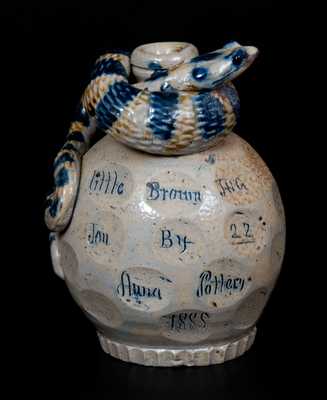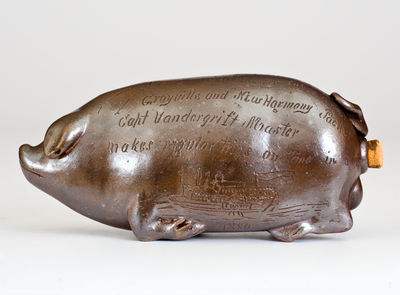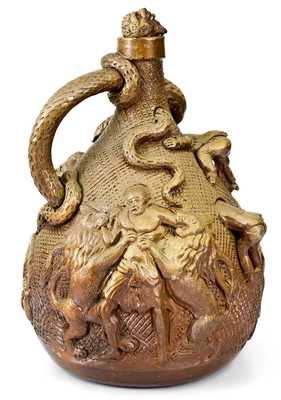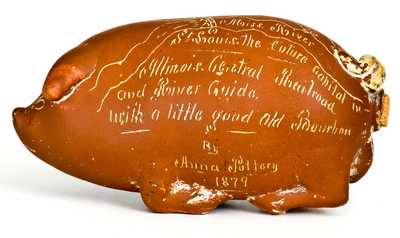Rare Anna Pottery Stoneware "Shoo Fly" Jug, Anna, IL, circa 1890-1896, ovoid jug with tooled spout, decorated with an applied clay figure of a woman grasping the neck of the jug with one arm and swatting at an applied fly with the other, the jug's front incised "Shoo Fly". Painted examples of this form indicate the female figure is meant to represent an African-American woman. This figure includes a well-sculpted billowing dress with incised details throughout and additional light incising to the blouse above. The woman is naked underneath her dress, a startling surprise revealed when the jug is tipped, and includes the inscription, "Original Package", incised between her legs. Additional incised details delineate the woman's fingers and facial features. The jug's surface is covered in a chocolate-brown Albany slip glaze. Aspects of the glaze and style of this jug suggest it was likely made during Anna Pottery's final years of production, circa 1890 to 1896. The phrase "Shoo Fly" is an apparent reference to the ubiquitous glass "shoo fly" flasks that came into vogue about this time. Known for having rounded sides in the manner of the Kirkpatricks' rendition, it is unclear from whence shoo fly flasks derived their name, but the term was certainly in use by the time this flask was made, and thus provided an opportunity for the Kirkpatricks, who were always quick to capitalize on a pun or other witticism: In this case, they use the name of the flask form to play off of the very popular tune of the time period, "Shoo Fly Don't Bother Me," written by a white man but whose long since censored lyrics were written as if sung by a stereotyped African-American Civil War soldier. The inscription, "Original Package," is probably an off-color pun, but as a phrase it was a common one in the commerce of liquor. As the temperance movement gained traction in the second half of the nineteenth century, local laws banning or otherwise wwregulating liquor sales often butted up against the concept of interstate commerce--which at least to some (including the Supreme Court, in one 1890 landmark decision) held that as long as the liquor remained in its original package, if imported into a state, it could be sold like any other good. This form is regarded as one of the most iconic creations of this important and highly-influential Midwestern pottery. Provenance: A fresh-to-the-market example, recently discovered in Florida. An approximately 1 5/8" long chip to bottom of dress and a minor chip to bottom edge of dress. Otherwise excellent condition with minor in-the-firing wear to bottom edge. This jug survives in overall good condition for the form, considering other surviving examples are missing most or all of the original dress. H 5 1/4".


















